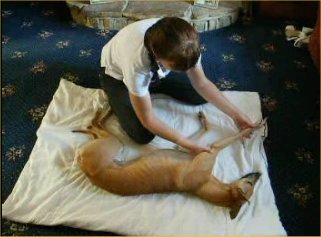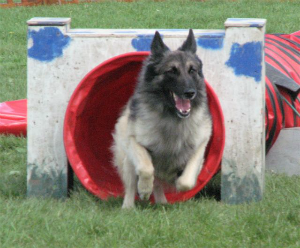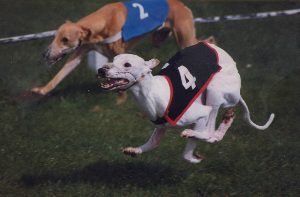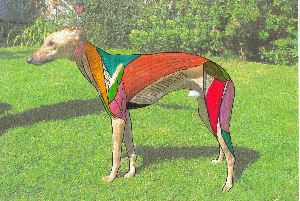 Dogs like people can suffer musculo-skeletal problems with pain in their backs, neck and pelvis and limbs.
Dogs like people can suffer musculo-skeletal problems with pain in their backs, neck and pelvis and limbs.
Often the dog’s only way of communicating this is to display changes in personality, character or performance. For example your dog may start having difficulty getting in or out of the car, up or downstairs or onto a favourite chair. He may not want to get out of bed or go for a walk and may show discomfort, growl or whimper when touched or picked up or worse still – bite. If he is a competition dog his performance may suffer causing him to become slower, less supple, knock fences, refuse to jump or sit / lay still. He may not stand squarely and his gait may be affected with shortened or uneven strides which often later can lead to lameness.
Misalignments, muscle tension and soreness can cause various symptoms and the  dog will often subtly change his gait to compensate for the problem. The joints involved become stiff and lack their normal range of motion. Ligaments will be put under extra strain, muscles will have reduced elasticity and will be more prone to injury. In addition nerves can become inflamed or impinged causing weakness and muscle wasting.
dog will often subtly change his gait to compensate for the problem. The joints involved become stiff and lack their normal range of motion. Ligaments will be put under extra strain, muscles will have reduced elasticity and will be more prone to injury. In addition nerves can become inflamed or impinged causing weakness and muscle wasting.
Problems occur in dogs for many reasons including the following:
- Trauma & Accidents -falls, road traffic accidents, slipping, fighting, playing.
- Repetitive activities – jumping on and off the sofa, in and out of the car, repeatedly running / jumping for a ball.
- Competitions – Agility dogs sudden stopping /starting / tight turns/ jarring). Obedience dogs turning always one way to look up and round at owner. Greyhound / Whippet racing running on tracks in one direction.
- Breed weakness – long back, short legged dogs are prone to disc problems. German Shepherds – Hip dysplasia
- Lameness – for example a dog with arthritis or hip dysplasia can cause the dog to compensate which can develop into secondary areas of soreness and a reduced range of movement.
- Dental problems.
- Stud & breeding duties.
Appointments for dogs will involve taking a full history and an explanation of the treatment. The dogs gait is analysed and in some circumstances dynamic observation can be videoed and digitally manipulated to show gaits in slow motion. Static assessment is made of the skeleton and muscles of the whole body taking into account asymmetry, joint ranges, misalignments, heat, inflammation and muscle spasm. Susan then uses a unique combination of McTimoney Chiropractic as well as soft tissue and massage techniques to perform a gentle, yet effective treatment suitable for almost any dog including young puppies and the older dog. Post treatment and preventative care advice is given before the end of appointment.
Current legislation means that animals may only be treated when veterinary consent has been given. Susan works very closely with owners vets and has several who refer directly to her. Where necessary if chiropractic treatment does not seem appropriate an animal will be referred back to your vet for further diagnosis, treatment or surgery.
 |
 |











